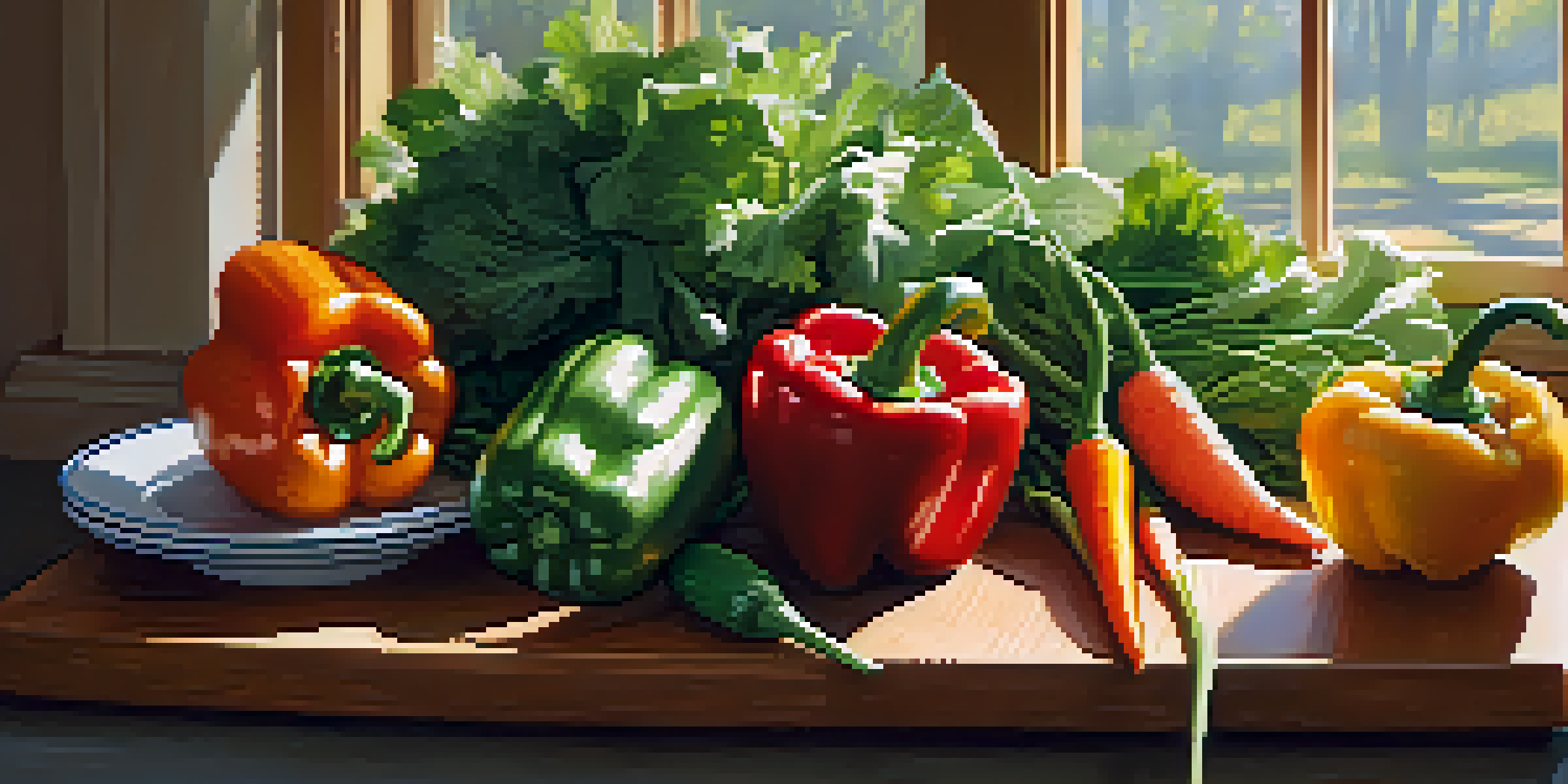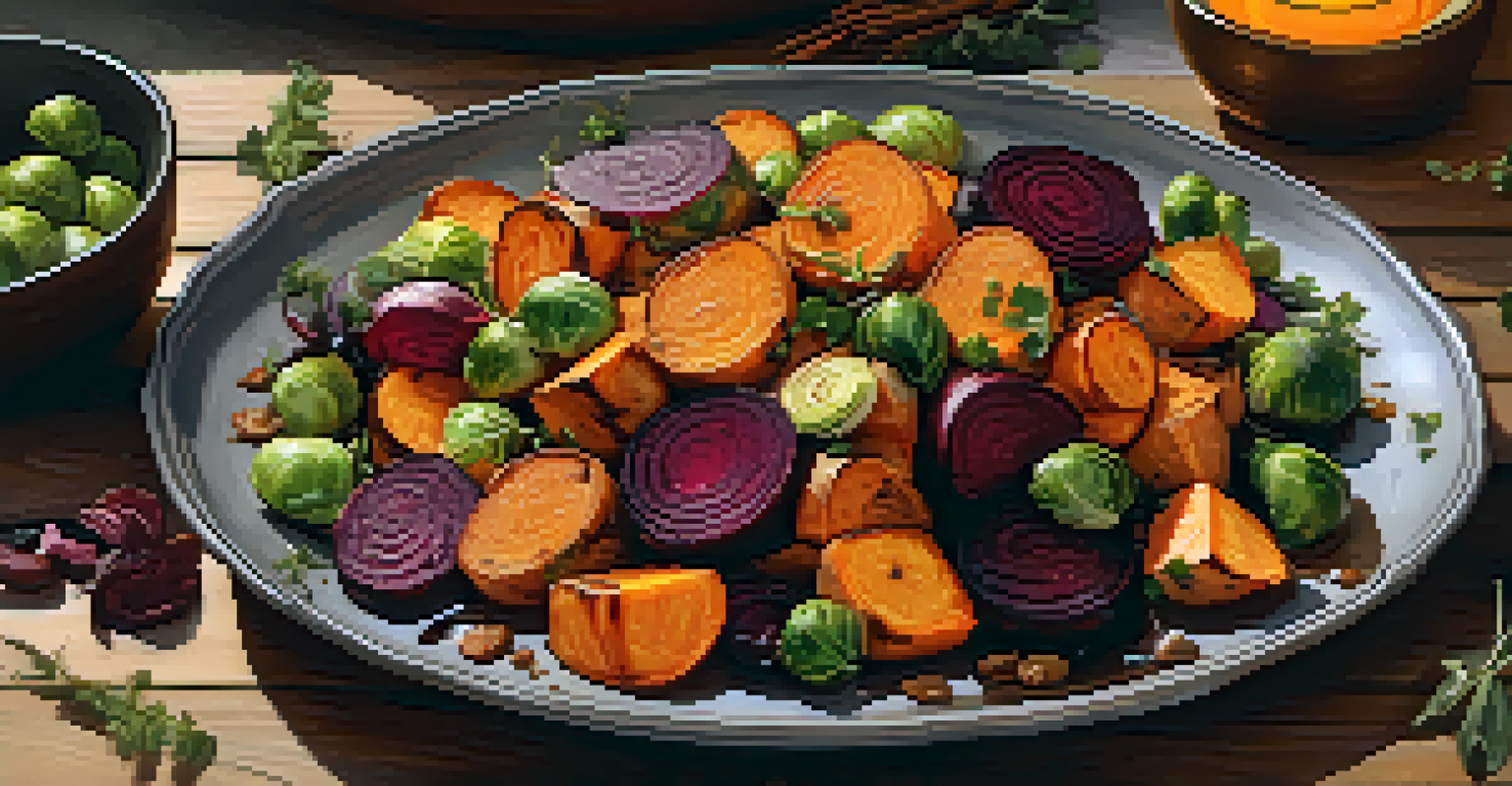Plant-Based Cooking Techniques: Healthy Methods to Explore

Understanding the Basics of Plant-Based Cooking
Plant-based cooking focuses on ingredients derived from plants, including fruits, vegetables, grains, nuts, and seeds. This approach not only promotes health but also emphasizes sustainability. It's important to understand the nutritional benefits of these foods, as they are often rich in vitamins, minerals, and fiber. By embracing plant-based cooking, you can create meals that are both wholesome and flavorful.
Let food be thy medicine and medicine be thy food.
At its core, plant-based cooking isn't about restriction; rather, it's about exploration. Think of it as a culinary adventure where you can experiment with different flavors and textures. Just like learning to ride a bike, the more you practice, the more comfortable you'll become with various techniques and ingredients. This exploration can lead to discovering new favorite dishes that are good for both you and the planet.
As you dive into plant-based cooking, keep in mind that versatility is key. Each plant-based ingredient can be transformed in countless ways, from roasting vegetables to making smoothies. This adaptability not only enhances your cooking skills but also keeps your meals exciting and fresh. The journey of plant-based cooking is an ongoing process, inviting you to learn, taste, and enjoy.
Embracing the Art of Steaming for Nutrient Preservation
Steaming is one of the healthiest cooking techniques you can adopt for plant-based meals. By using steam to cook vegetables, you help retain their nutrients, color, and texture, making them more appealing on your plate. Unlike boiling, which can leach nutrients into the water, steaming ensures that your veggies maintain their health benefits while also enhancing their natural flavors.

Imagine biting into a perfectly steamed broccoli floret—it’s tender, vibrant, and packed with nutrients. This technique works well for various vegetables, from leafy greens to root vegetables. The best part? It’s incredibly simple! Just add water to a pot, bring it to a boil, and place your vegetables in a steam basket above. In just a few minutes, you’ll have a nutritious side dish ready to complement any meal.
Explore Plant-Based Cooking
Plant-based cooking invites you to experiment with diverse ingredients and techniques to create flavorful, nutritious meals.
Moreover, steaming can also be used for grains and legumes, making them more digestible. Think about incorporating steamed quinoa or lentils into your salads for added protein and texture. By mastering this technique, you’ll not only elevate the nutritional value of your meals but also discover how delicious healthy eating can be.
Sautéing: A Flavorful Technique for Plant-Based Meals
Sautéing is a quick and versatile cooking method that allows you to infuse flavors into your plant-based dishes. By cooking ingredients in a small amount of oil or broth over medium-high heat, you can create a caramelized exterior and a tender interior. This technique is perfect for bringing out the natural sweetness in vegetables, such as bell peppers and onions, enhancing their appeal.
The food you eat can either be the safest and most powerful form of medicine or the slowest form of poison.
Imagine tossing fresh vegetables in a hot pan, hearing that satisfying sizzle! This sound signals that you’re on your way to a delicious, aromatic meal. You can also add garlic, herbs, or spices while sautéing to elevate flavors further. This method doesn’t just apply to vegetables; you can sauté tofu or tempeh for a hearty protein addition in stir-fries or grain bowls.
Additionally, sautéing is a great way to use up leftover vegetables in your fridge. By combining various veggies, you can create a vibrant stir-fry that’s not only tasty but also minimizes food waste. This technique encourages creativity in the kitchen, allowing you to experiment with different combinations and sauces to suit your taste buds.
Roasting: Enhancing Natural Flavors Through Heat
Roasting is a fantastic way to bring out the natural sweetness and flavors of plant-based ingredients. By cooking them in the oven at high temperatures, you create a crispy exterior while keeping the inside tender. Root vegetables like carrots, sweet potatoes, and beets are especially delicious when roasted, as the heat caramelizes their natural sugars, resulting in a rich, complex flavor.
To get started, simply chop your vegetables, toss them with a bit of olive oil, salt, and your favorite herbs, and spread them on a baking sheet. Roasting not only enhances flavors but also adds a satisfying crunch that makes vegetables more appealing. Imagine serving roasted Brussels sprouts with a balsamic glaze—they’re hard to resist!
Health Benefits of Cooking Methods
Techniques like steaming, sautéing, and roasting help preserve nutrients and enhance the natural flavors of plant-based ingredients.
In addition to vegetables, you can also roast legumes, nuts, or even fruits for a delightful treat. Roasted chickpeas make a crunchy snack, while roasted apples can be a warm dessert. The versatility of roasting allows you to explore various flavor profiles, making it a go-to technique in your plant-based cooking repertoire.
Blending: Creating Smoothies and Soups with Ease
Blending is a simple yet effective technique for creating delicious and nutritious plant-based meals. Whether you’re whipping up a smoothie for breakfast or a creamy soup for dinner, a blender can transform whole ingredients into delightful dishes. This method not only helps you incorporate more fruits and vegetables into your diet but also makes it easy to experiment with flavors and textures.
Imagine starting your day with a vibrant green smoothie packed with spinach, banana, and almond milk. Blending these ingredients together results in a refreshing drink that’s both satisfying and energizing. You can get creative by adding superfoods like chia seeds or nut butter for an extra nutritional boost.
Similarly, blending can be a game-changer for soups. By pureeing roasted vegetables with vegetable broth, you can create a silky-smooth soup in minutes. This technique allows you to enjoy comforting meals that are packed with nutrients and flavor, proving that healthy eating doesn’t have to be boring or complicated.
Grilling: Adding Smoky Flavors to Your Plant-Based Dishes
Grilling is a fantastic cooking technique that adds a delightful smoky flavor to your plant-based meals. Whether you’re cooking vegetables, tofu, or even fruit, grilling enhances the natural flavors and creates a satisfying char that elevates the dining experience. Picture a summer barbecue where fresh corn, zucchini, and bell peppers are cooked to perfection on the grill—delicious and visually appealing!
To get the most out of grilling, marinating your ingredients beforehand can make a significant difference. A simple marinade of olive oil, lemon juice, and herbs can transform ordinary vegetables into something extraordinary. You can use skewers to create colorful veggie kebabs, making it easy to serve at gatherings or family dinners.
Fermentation for Gut Health
Fermenting foods adds probiotics to your diet, improving gut health while introducing unique flavors to your meals.
Grilling isn’t just for savory dishes; fruits like peaches and pineapples can be grilled to enhance their sweetness. A grilled peach with a scoop of dairy-free ice cream makes for a delightful dessert. By incorporating grilling into your plant-based cooking techniques, you’ll enjoy meals that are not only healthy but also packed with flavor.
Fermenting: Discovering the Benefits of Probiotic Foods
Fermenting is an ancient technique that enhances flavors while boosting the nutritional value of plant-based foods. By allowing beneficial bacteria to break down sugars and starches, fermentation creates probiotics that can improve gut health. Foods like sauerkraut, kimchi, and miso are excellent examples of how fermentation can enhance your meals and overall well-being.
Imagine adding a spoonful of tangy kimchi to your rice bowl, instantly elevating the dish with its bold flavors and crunch. Fermented foods can easily be incorporated into various meals, providing a unique taste and texture. Plus, the process of making your own fermented foods at home can be a fun and rewarding experience!

While fermentation may seem intimidating, it’s quite simple to get started. You can begin with easy recipes, like pickling vegetables or making your own yogurt alternative. As you explore this technique, you’ll not only enjoy the benefits of probiotics but also discover new flavors that will enhance your plant-based meals.
Conclusion: Embracing Plant-Based Cooking Techniques for a Healthier Life
Incorporating various plant-based cooking techniques into your routine can transform your meals and overall health. From steaming and sautéing to roasting and fermenting, each method offers unique benefits and allows for endless creativity in the kitchen. By embracing these techniques, you can enjoy delicious, nutritious meals that align with your health goals.
As you experiment with these cooking methods, remember that the journey is just as important as the destination. Don’t be afraid to try new ingredients or flavors—this exploration can lead to delightful culinary discoveries. The more you practice, the more confident you’ll become in your plant-based cooking skills.
Ultimately, the goal is to enjoy the process and create meals that nourish both your body and soul. With each dish you prepare, you’re not just cooking; you’re contributing to a healthier lifestyle and a more sustainable planet. So, grab your apron and start exploring the wonderful world of plant-based cooking today!